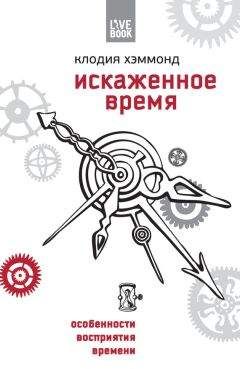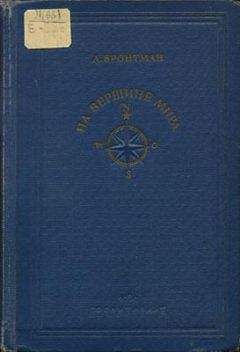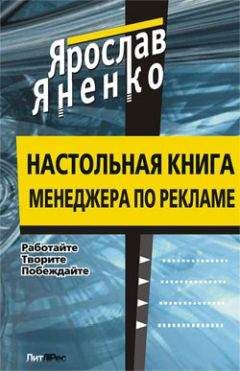Клодия Хэммонд - Искаженное время. Особенности восприятия времени

Помощь проекту
Искаженное время. Особенности восприятия времени читать книгу онлайн
Levine, R. (2006) A Geography of Time: The temporal misadventures of a social psychologist. Oxford: Oneworld.
Lewis, P.A. & Miall, R.C. (2009) The precision of temporal judgement: milliseconds, many minutes, and beyond. Philosophical Transactions of the Royal Society, B, 364, 1897—1905.
Liberman, N. & Trope, Y. (1998) The role of feasibility and desirability considerations in near and distant future decisions: A test of temporal construal theory. Journal of Personality and Social Psychology, 75, 5–18.
Linton, M.R. (1988) ‘Ways of searching and the contents of memory’. In Rubin, M.R. (ed.) Autobiographical Memory. Cambridge University Press: Cambridge.
Linton, M. (1975) ‘Take-two-items-a-day-for-five-years study’. In Norman, D.A. et al. (eds) Explorations in Cognition. W.H. Freeman: San Francisco.
Loewenstein, G. & Frederick, S. (1997) ‘Predicting reactions to environmental change’. In Bazerman, H.H. et al. (eds.) Environment, Ethics & Behaviour. San Francisco: New Lexington.
Loftus, E.F. et al. (1987) Time went by so slowly: Overestimation of event duration by males and females. Applied Cognitive Psychology, I, 3–13.
Logan, C.J. et al. (2011) A case of mental time travel in ant-following birds? Behavioral Ecology, 22(6), 1149—1153.
Mangan, P.A. et al. (1996) Altered time perception in elderly humans results from the slowing of an internal clock. Society for Neuroscience Abstracts, 22, 183.
Mann, H. et al. (2009) Time-space synaesthesia – a cognitive advantage? Consciousness and Cognition, 18, 619—627.
Манн, Томас. Волшебная гора. Николаев: «Крус», 1994.
Margulies, S.O. & Crawford, L.E. (2008) Event valence and spatial metaphors of time. Cognition & Emotion, 22(7), 1401—1414.
Marshall, F. (undated) History of the Philological society: The early years. http://www.philsoc.org.uk/history
Maycock, G. et al. (1991) The accident liability of car drivers. TRL Research Report 315. Berkshire: Transport Research Laboratory TRL.
McGaugh, J.L. (2003) Memory and Emotion. London: Weiden-feld & Nicolson.
McNally, R.J. (2003) Remembering Trauma. Cambridge, Mass.: The Belknap Press.
McTaggart, J.E. (1908) The unreality of time. Mind, 17, 456–73.
Merritt, D.J. et al. (2010) Do monkeys think in metaphors? Representations of space and time in monkeys and humans. Cognition, 117, 191—202.
Miles, L. et al. (2010) Moving through time. Psychological Science, 21(2), 222—223.
Mischel, W. et al. (1989) Delay of gratification in children. Science, 244, 933—938.
Newby-Clark, I.R. & Ross, M. (2003) Conceiving the past and future. Personality and Social Psychology Bulletin, 29, 807—818.
Noulhiane, M. et al. (2007) How emotional auditory stimuli modulate time perception. Emotion, 7(4), 697—704.
Nussbaum, S. et al. (2006) Predicting the near and distant future. Journal of Experimental Psychology, 135, 152—161.
O’Reilly, K. (2000) The British in the Costa del Sol. London: Rout-ledge.
Ofcom (2010) The Communications Market 2010. London: Ofcom.
Poppel, E. (2009) Presemantically defined temporal windows for cognitive processing.
Prohaska, V. et al. (1998) Forward telescoping: the question matters. Memory, 6, 455—465.
Путнэм, Роберт. Игра в гольф в одиночку: размывание общественного капитала в Америке: http://old.russ.ru/ journal/peresmot/97-09–17/putnam.htm.
Rosenbaum et al. (2005) The case of K.C.: Contributions of a memory-impaired person to memory theory. Neuropsychologia, 43, 989–1021.
Ross, M. & Wilson, A.E. (2002) It feels like yesterday: Self-esteem, valence of personal past experiences, and judgments of subjective distance. Journal of Personality and Social Psychology, 2002, 82(5), 792—803.
Schacter, D. (1996) Searching for Memory. New York: Basic Books.
Schacter, D.L. & Addis, D.R. (2007) The cognitive neuroscience of constructive memory: Remembering the past and imagining the future. Philosophical Transactions of the Royal Society, B, 362, 773—786.
Schleidt, M.M. & Eibesfeldt, E. (1987) A universal constant in temporal segmentation of human short-term behaviour. Natur-wissenshaften, 74, 289—290.
Sevinc, E. (2007) The effects of extensive musical training on time perception regarding hemispheric lateralization, different time ranges and generalization to different modalities. PhD thesis retrieved 10.01.12. from http://cogprints.org/6171.
Shield, R/ (1994) Extracts from diary. NPR Sound portraits. http://www.soundportraits.org/on-air/worlds_longest_diary/ diary_entry1.gif.
Shneidman, E.S. (1973) Suicide notes reconsidered. Psychiatry, 36, 379—393.
Shu, S.B. & Gneezy, A. (2010) Procrastination of enjoyable experiences. Journal of Marketing Research, 47(5) 933—934.
Сифр, Мишель. Один в глубинах Земли. М.: «Мир», 1966.
Skowronski, J.J. et al. (2003) Ordering out world: An examination of time in autobiographical memory. Memory, 11, 247—260.
Августин А. Исповедь. М.: «Ренессанс», 1991.
Steinberg, L. et al. (2009) Age differences in future orientation and delay discounting. Child Development, 80(I), 28—44.
Suddendorf, T. & Corballis, M.C. (2007) The evolution of foresight: What is mental time travel and is it unique to humans? Behavioral and Brain Sciences, 30, 299—313.
Szpunar, K.K. & McDermott, K.B. (2008) Episodic future thought and its relation to remembering: Evidence from ratings of subjective experience. Consciousness and Cognition, 17, 330—334.
Szpunar, K.K. et al. (2007) Neural substrates of envisioning the future. Proceedings of the National Academy of Sciences, 104, 642—647.
Тейлор, Стив. Покорение времени. Как время воздействует на нас, а мы на время. М.: «Альпина нон-фикшн», 2010.
Taylor, S.E. et al. (1998) Harnessing the imagination: Mental simulation, self-regulation and coping. American Psychologist, 53, 429—439.
Tobin, S. et al. (2010) An ecological approach to prospective and retrospective timing on long durations: A study involving gamers. PLoS One, 5(2), e9271.
Twenge, J.M. et al. (2003) Social exclusion and the deconstructed state: Time perception, meaningless, lethargy, lack of emotion, and self-awareness. Journal of Personality and Social Psychology, 85(3), 409—423.
Van Boven, L. & Ashworth, L. (2007) Looking forward, looking back: Anticipation is more evocative than retrospection. Journal of Experimental Psychology: General, 136, 289—300.
van Wassenhove, V. (2009) Minding time in an amodal representational space. Philosophical Transactions of the Royal Society, B, 364, 1815—1830.
Vicario, C. et al. (2010) Time processing in children with Tourette’s syndrome. Brain and Cognition, 73 (I), 28—34.
Wagenaar, W.A. (1986) My memory: A study of autobiographical memory over six years. Cognitive Psychology, 18, 225–52.
Wakslak, C.J. et al. (2008) Representations of the self in the near and distant future. Journal of Personality and Social Psychology, 95, 757—773.
Walker et al. (2003) Life is pleasant – and memory helps to keep it that way. Review of General Psychology, 7(2), 203—210.
Ward, J. (2008) The Frog who Croaked Blue. London: Routledge.
Weick, K.E. (1995) Sensemaking in Organizations. California: Sage Publications.
Williams, M. & Penman, D. (2011) Mindfulness: A practical guide to finding peace in a frantic world. London: Piatkus.
Wilson, T. et al. (2000) Focalism: A source of durability bias in affective forecasting. Journal of Personality and Social Psychology, 78(5), 821—836.
Wittman, M. (2009) The inner experience of time. Philosophical Transactions of the Royal Society, B, 364, 1955—1967.
Wyllie, M. (2005) Lived time and psychopathology. Philosophy, Psychiatry & Psychology, 12 (3), 173—185.
Zakay, D. & Block, R.A. (1997) Temporal Cognition. Current Directions in Psychological Science, 6, 12—16.
Zerubavel, E. (2003) Time Maps: Collective memory and the shape of the social past. Chicago: University of Chicago Press.
Zerubavel, E. (1981) Hidden Rhythms: Schedules and calendars in social life. Chicago: University of Chicago Press.
Zhong, C. & DeVoe, S. (2010) You are how you eat: Fast food and impatience. Psychological Science, 21, 619—622.
Зимбардо, Ф. и Бойд, Дж. Парадокс времени. Новая психология времени, которая улучшит вашу жизнь. СПб: «Речь», 2010.
Примечания
1
Мак-Таггарт (1908).
2
Чжун и Дево (2010).
3
http://news.bbc.co.uk/1/hi/5104778.stm.
4
Описано у Джемса (1890).
5
Гуссерль (1893).
6
Зерубавель (2003).
7
Boring (англ.) – здесь: зануда (Прим. перев.)
8
Барг и др. (1996).
9
Лофтус и др. (1987).
10
Твендж и др. (2003).
11
Шнайдман (1973).
12
Брум (2005).
13
Уайли (2005).
14
Уиттман (2009).
15
Котар (1882).
16
Лифхэд и Копельман (1999).
17
Бэддли (1966).
18
Хогланд (1933).
19
Холберг и др. (2008).
20
Хант (2008).
21
Хендерсон и др. (2006)
22
Кох (2002).
23
Викарио и др. (2010).
24
До свидания (франц.)
25
Крейг (2009).
26
Одд-болл-эффект – эффект проявления редкого стимула, отличающегося от всех остальных и привлекающего внимание непроизвольно. (Прим. перев.)
27
Севинч (2007).
28
Пёппель (2009)
29
Шлейдт и Эйбесфельдт (1987).
30
Джемс (1890).
31
Льюис и Майалл (2009).
32
Закай и Блок (1997).
33
Бар-Хайм и др. (2010).
34
Лангер и др. (1961).
35
Нулхиан и др. (2007).
36
Ван Вассенхов (2009).
37
http://www.neurobio.ucla.edu/~dbuono/InterThr.htm.
38
Буономано и др. (2009).
39
Иглмен и Париядат (2009).
40
Сифр (1965).
41
Фостер и Крейцман (2003)
42
Уорд (2008).
43
Перевод с англ. Марии Фаликман.
44
Тедди-бой – молодежная субкультура 1950-х годов в Великобритании; молодые люди из рабочего класса подражали «золотой молодежи», одеваясь по моде эпохи Эдуарда VII. (Прим. перев.)
45
Манн и др. (2009).
46
Уорд (2008).
47
Spatial-numerical assoiation of response codes; ассоциирование расположения кнопки для ответа с величиной числа – вследствие того, что числа расположены вдоль воображаемой линии слева направо, на большие числа быстрее откликаются правой рукой, а на маленькие – левой. (Прим. ред.)

























